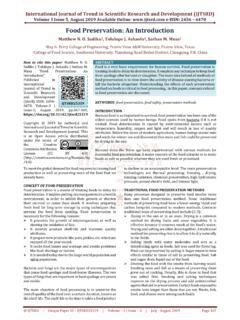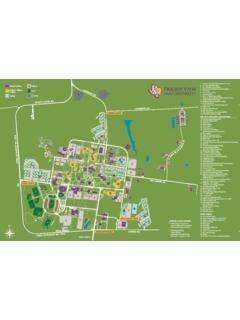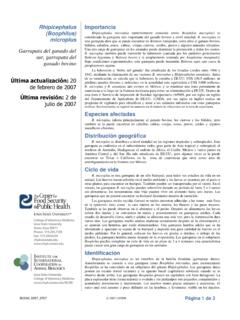Transcription of Artificial Intelligence in Autonomous Vehicles
1 International Journal of Trend in Scientific Research and Development (IJTSRD) Volume 5 Issue 2, January-February 2021 Available Online: e-ISSN: 2456 6470 @ IJTSRD | Unique Paper ID IJTSRD38514 | Volume 5 | Issue 2 | January-February 2021 Page 715 Artificial Intelligence in Autonomous Vehicles Matthew N. O. Sadiku1, Sarhan M. Musa1, Abayomi Ajayi-Majebi2 1 Roy G. Perry college of Engineering, Prairie View A&M University, Prairie View, texas 2 Department of Manufacturing Engineering, central State University, Wilberforce, Ohio ABSTRACT An Autonomous vehicle is one that uses a combination of sensors, cameras, radar, and Artificial Intelligence (AI) to travel between destinations without a human operator. It is designed to be able to detect objects on the road, maneuver through the traffic without human intervention, and get to the destination safely. It is fitted with AI-based functional systems such as voice and speech recognition, gesture controls, eye tracking, and other driving monitoring systems.
2 Several companies have announced their plan to get involved in Autonomous or driverless and electric vehicle technology. This paper presents uses of AI technology in Autonomous Vehicles . KEYWORDS: Autonomous Vehicles , driverless Vehicles , Artificial Intelligence , Artificial Intelligence in Autonomous Vehicles , Unmanned Ariel Vehicles How to cite this paper: Matthew N. O. Sadiku | Sarhan M. Musa | Abayomi Ajayi-Majebi " Artificial Intelligence in Autonomous Vehicles " Published in International Journal of Trend in Scientific Research and Development (ijtsrd), ISSN: 2456-6470, Volume-5 | Issue-2, February 2021, , URL: Copyright 2021 by author(s) and International Journal of Trend in Scientific Research and Development Journal. This is an Open Access article distributed under the terms of the Creative Commons Attribution License (CC BY ) ( ) INTRODUCTION Engineers and scientists all over the globe are struggling to make human life more comfortable.
3 One of their most spectacular recent developments is Autonomous vehicle (AV). Autonomous Vehicles have been hitting the headlines lately. They usually refer to self-driving Vehicles that can fulfill transportation capabilities of a traditional vehicle. They are not designed to obey the law but for the purposes of promoting safe and efficient traffic and driving from A to B [1]. They are regarded as a post-Uber disruption to public commute and transportation of goods. They are starting to become a real possibility in main economic sectors such as transportation, agriculture, and military. AV technology is regarded as a significant market disruptor for multiple industries [2]. A host of auto heavyweights are investing in Autonomous R&D and developing road-going self-driving Vehicles . Such companies include Amazon, Audi, Apple, Waymo, Tesla, BMW, Google, General Motors, Volkswagen, Volvo, Ford Motor, IBM, Microsoft, Mercedes-Benz, Bosch, Nissan, Alphabet, Honda Motor, and Uber Technologies.
4 The United States is presently the largest automobile market in the world. Vehicles with crash-warning systems, lane-keeping framework, adaptive cruise control system, anti-lock braking systems, automatically activated safety mechanisms, and self-parking technology are already in use in the United States. Autonomous vehicle (AV) is one of the key application areas of Artificial Intelligence (AI). In other words, AI is the most important component of Autonomous and connected Vehicles . This is due to the humongous amount of environmental data generated by the vehicle. AVs depend on AI to interpret the environment, understand its conditions, and make driving-related decisions. Autonomous Vehicles employ numerous cameras, sensors, radars, communication systems, and AI technology to enable the vehicle to generate massive amounts of data which can be processed in fractions of a second to help the vehicle to see, hear, think and make decisions just like human drivers do.
5 A typical Autonomous vehicle is shown on Figure 1 [3]. Autonomous Vehicles have been in development for almost thirty years. For a vehicle to be Autonomous , it must be continuously aware of its surroundings, by perceiving and then acting on the information. SAE International has suggested the following levels of driving automation, illustrated in Figure 2 [4]: Automation for driver assistance: This is a preliminary level or starting point of car automation where the system assists the driver but does not take control of the car. Partially automated driving: The system takes partial control, but the driver is primarily responsible for the operation of the vehicle. Highly automated driving: This allows users to let the system take control of the vehicle for a longer duration of time ( , on the highway). Fully automated driving: The system is responsible for driving the vehicle without interference from any human.
6 However, the human presence is still needed. IJTSRD38514 International Journal of Trend in Scientific Research and Development (IJTSRD) @ eISSN: 2456-6470 @ IJTSRD | Unique Paper ID IJTSRD38514 | Volume 5 | Issue 2 | January-February 2021 Page 716 Completely automated car: The vehicle can completely navigate its way through from one point to another without any assistance from a driver. OVERVIEW ON Artificial Intelligence The term Artificial Intelligence (AI) was first used at a Dartmouth college conference in 1956. AI is now one of the most important global issues of the 21st century. AI is the branch of computer science that deals with designing intelligent computer systems that mimic human Intelligence , visual perception, speech recognition, decision-making, and language translation. The ability of machines to process natural language, to learn, to plan makes it possible for new tasks to be performed by intelligent systems.
7 The main purpose of AI is to mimic the cognitive function of human beings and perform activities that would typically be performed by a human being. Without being taught by humans, machines use their own experience to solve a problem. AI is stand-alone independent electronic entity that functions much like human expert. Today, AI is integrated into our daily lives in several forms, such as personal assistants, automated mass transportation, aviation, computer gaming, facial recognition at passport control, voice recognition on virtual assistants, driverless cars, companion robots, etc. AI is not a single technology but a range of computational models and algorithms. Some forms of AI that are most commonly used in different applications include the following [5,6]: Expert systems: They solve problems with an inference engine that draws from a knowledge base equipped with information about a specialized domain, mainly in the form of if-then rules.
8 Expert systems are the earliest, most extensive, the most active, and most fruitful area. Fuzzy logic: This makes it possible to create rules for how machines respond to inputs that account for a continuum of possible conditions, rather than straightforward binary. Neural networks: These are specific types of machine learning systems that consist of Artificial synapses designed to imitate the structure and function of brains. They are similar to the human brain. They are made up of Artificial neurons, take in multiple inputs, and produce a single output. The network observes and learns as the synapses transmit data to one another, processing information as it passes through multiple layers. Machine learning: This includes a broad range of algorithms and statistical models that make it possible for systems to find patterns, draw inferences, and learn to perform tasks without specific instructions.
9 Machine learning is a process that involves the application of AI to automatically perform a specific task without explicitly programming it. ML techniques may result in data insights that increase production efficiency. Today, Artificial Intelligence is narrow and mainly based on machine learning. Deep learning: This is a form of machine learning based on Artificial neural networks. Deep learning architectures are able to process hierarchies of increasingly abstract features, making them especially useful for purposes like speech and image recognition and natural language processing. Deep learning networks can deal with complex non-linear problems. Deep learning is expected to be the largest and the fastest-growing technology in the automotive AI market.\ Natural Language Processors: For AI to be useful to us humans, it needs to be able to communicate with us in our language.
10 Human language is complex, but AI can be trained to slowly pick up the language. Computer programs can translate or interpret language as it is spoken by normal people. Robots: These are computer-based programmable machines that have physical manipulators and sensors. Sensors can monitor temperature, humidity, pressure, time, record data, and make critical decisions in some cases. Robots have moved from science fiction to your local hospital. In jobs with repetitive and monotonous functions they might even completely replace humans. Robotics and Autonomous systems are regarded as the fourth industrial revolution. These AI tools are illustrated in Figure 3 [7]. Each AI tool has its own advantages. Using a combination of these models, rather than a single model, is recommended. AI systems are designed to make decisions using real-time data. They have the ability to learn and adapt as they make decisions.













